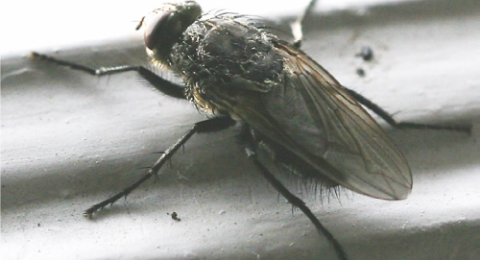The large sluggish flies known as cluster or “attic" flies (Pollenia rudis and relatives) often invade New Hampshire homes in fall and turn into wintertime pests. They are particularly noticeable on warm winter days when they become active and find their way into living quarters. Just when you think you have them under control, more appear the next day, creating the impression they are breeding inside the house. In reality, they are only using your home as a place to spend winter and do not cause damage to the buildings, furniture, or occupants.

Bugwood.org
Life Cycle
To the layperson, cluster flies have no obvious characteristics that distinguish them from ordinary house flies. During summer, cluster flies are active outdoors, where they are parasitic on earthworms. Adult females lay their eggs near the openings of earthworm burrows. Upon hatching, the young larvae move into the burrows and penetrate the earthworms’ bodies. After feeding on the worms, the fly larvae pupate in the soil. The adults emerge to repeat the cycle, with up to four generations being produced each summer.
In fall, the adults from the last generation seek protected areas in which to spend winter. They invade attics, get under siding and around windows and into crevices on the outside of buildings. Many eventually congregate between the walls and may work their way into a room through openings in the window frames and electrical fixtures. On warm days in early spring they move outdoors and are often seen covering the sunny side of houses.
Management
IPM Strategies:
- Cultural Practices - (1) Barriers: The best line of defense against cluster flies is to prevent their entrance into buildings. Where possible, seal up cracks in the siding and around windows with caulking and cover attic vents with wire screening before September 10th.
(2) Physical Removal: Cluster flies are usually sluggish and make little attempt to escape, so they can easily be picked up with a vacuum cleaner or swatted with a fly swatter. If you use a vacuum cleaner to clear up sluggish flies, remove the bag and place it outdoors, or the flies inside may crawl back out.
(3) Traps: Resin strips (flypaper) may be hung in infested area if there is little or no air movement.
- Chemical Control - Using insecticides should be the last consideration after all other attempts for control have been exhausted (sanitation, barriers, traps, and physical removal). In cases where insecticides are necessary, there are a variety of products to choose from, including baits, liquids, aerosols, and dusts. Consult your local Cooperative Extension Service for specific recommendations.
Stop! Read the label on every pesticide container each time before using the material. Pesticides must be applied only as directed on the label to be in compliance with the law. All pesticides listed in this publication are contingent upon continued registration. Contact the Division of Pesticide Control at (603) 271-3550 to check registration status. Dispose of empty containers safely, according to New Hampshire regulations.
By Alan T. Eaton, Extension Specialist, Entomology
Updated by Alan T. Eaton and Rachel Maccini, August 2016
Extension Services & Tools That Help NH Farmers Grow
Newsletters: Choose from our many newsletters for production agriculture
Receive Pest Text Alerts - Text UNHIPM to (866) 645-7010




